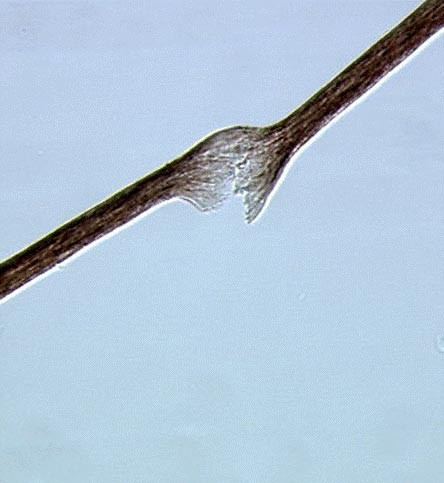Specialty dermatology ICD-9-CM 704.2 MedlinePlus 001449 | ICD-10 L67.0 DiseasesDB 29680 | |
 | ||
Trichorrhexis nodosa is a defect in the hair shaft characterized by thickening or weak points (nodes) that cause the hair to break off easily. This group of conditions contributes to the appearance of hair loss, lack of growth, and damaged-looking hair.
Contents
Causes, incidence, and risk factors
Trichorrhexis may have a genetic basis but appears to be precipitated by environmental factors. Among Caucasians the defect often appears at the ends of the hair shaft with splitting of the ends, thinning and whitish discoloration.
These conditions are directly related to environmental causes such as "perming", blow drying, aggressive hair brushing, and excessive chemical exposure.
In some cases, trichorrhexis nodosa may be caused by an underlying disorder such as argininosuccinic aciduria, Menkes' kinky hair syndrome, Netherton's syndrome, hypothyroidism, or trichothiodystrophy.
Symptoms
Signs and tests
Examination of the hair shafts with a microscope may reveal changes of trichorrhexis nodosa.
Treatment
Improving environmental factors will reduce damage to the hair. Gentle brushing with a soft brush should replace more aggressive brushing, ratting, or other procedures. Harsh chemicals such as hair straightening compounds and permanents should be avoided. The hair should not be ironed. Excessively harsh shampoo should be avoided. Hair conditioners should be used.
Prognosis
This condition is self-limiting. Improvements in grooming techniques and in environmental conditions will correct the abnormality.
Complications
This condition is not dangerous but may affect self-esteem.
Prevention
Avoid aggressive brushing and grooming, strong chemicals, permanents, straightening, and similar hair-damaging habits.
